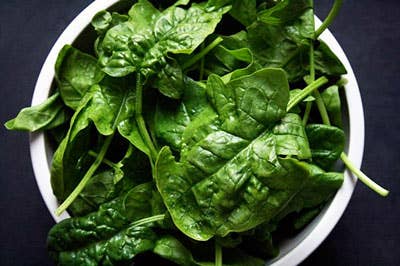
Winter Vegetables: Spinach
Winter can be a sleepy time on a farm. After months of exhausting physical labor and long days at markets, the winter season brings farmers at least a moment's rest. But active farming is a year-round endeavor at Stone Barns Center for Food & Agriculture, the celebrated farm and educational center in Pocantico Hills, New York that is also home to chef Dan Barber's Blue Hill at Stone Barns restaurant.
While the harvests do slow down some, there is a remarkable amount of bustle at Stone Barns during the colder months. Jack Algiere, a farmer whose official title is "four-season grower," plants all kinds of vegetables in the fields (under protective raised polytunnels) and in the half-acre greenhouse, from pearl onions, kale, and arugula to Jerusalem artichokes, Brussels sprouts, collards, and broccoli. And then there's the spinach, quite possibly the farm's most popular winter vegetable. Algiere said that an impressive 10-15 percent of the greenhouse is devoted to spinach year-round, with an additional half-acre planted in the fields from December through February.
Unlike summer spinach's pale, wispy leaves, winter varieties like Bloomsdale are hefty, creased, and deeply green. As for the taste, Algiere says that winter spinach is far superior. The full flavor, he said, stems from the longer growing period, which allows more sugars to accumulate in the plant. As a result, winter spinach is substantial enough to stand up to hearty preparations like a vibrant spinach soup topped with a drizzle of olive oil, spinach and feta bread, or pumpkin, goat cheese, and spinach tarts, as well as gentler preparations like spinach egg salad and spinach salad with persimmon and jicama.
Stone Barns is renowned for its innovative, forward-thinking approach to growing, but it is not alone when it comes to winter spinach production. The Snug Haven farm in Wisconsin sells their spinach to nearby restaurants and through winter CSA shares, as does New Hampshire's Milk and Honey farm. Together, these growers (and many others) cultivate sustainable growing practices year-round, and help to brighten up winter dinner tables with a delicious—and much-needed—burst of green.
Buying Tips
Season: Stone Barns grows their spinach all year long, switching to hardier varieties like Bloomsdale in the colder months. In supermarkets, spinach can be found all year as well.
Where to find it: Scan your local farmers' markets for growers offering winter greens. When dining out, check the menu at seasonally focused restaurants to see if they offer winter spinach dishes.
Price: Prices will vary widely from market to market. Stone Barns sells their spinach for $10/lb year-round. In supermarkets, bags of winter spinach cost $3-$5, and bunches run between $1.50-$3.50.
Leah Koenig is a freelance writer, home cook, and food columnist for the Forward.
Keep Reading
Continue to Next Story










